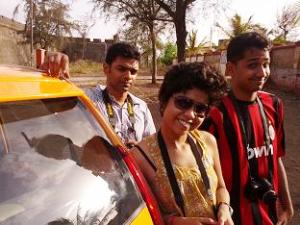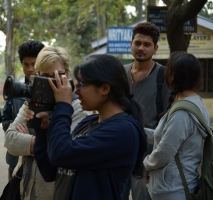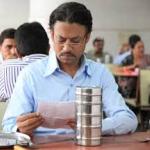When I embarked on writing the book Disappearing Daughters, female foeticide was, to me, what we in journalistic parlance call "a story". To track this story I decided to use the only tools I knew to handle the old fashioned tools of investigative reporting
I have been a journalist for a very long time. In fact, when I joined Indian Express as the junior most reporter in 1969, I became Bangalore's very first woman reporter in English.
In the beginning I was battling to establish my identity as a woman in an all-male world. But, as the years rolled by I realized that my gender was my Unique Selling Point. Because I was a woman I could go where no man could go! This was how I became interested in writing on gender issues.
I speak about this because the story of the alarming manner in which female foeticide has taken root in our country could never have been told if I had not been a woman reporter.
Female foeticide is a secret and hidden crime. To probe it required not just patience and doggedness but also a lot of empathy. Getting people to confide in me was not easy. Wherever I went, I was an outsider.
I started my research with a great deal of trepidation. There was plenty of research data available on the subject, but somewhere along the line the human face had gone missing. Were families really killing their daughters in such great numbers? It must be so because the census figures indicated that the sex ratios were going totally awry and at an alarming rate in some parts of the country.
If the girl babies were being killed, when did it happen? While they were still in the womb or after they were born? Who killed them and how? Did it happen in educated families or was it only the poor and disempowered who killed their daughters? These were very difficult questions to answer.
I knew that my story would not come easily. What I did not really expect was the momentum the story would gather.
As the months rolled by, I found that the story of our Disappearing Daughters became bigger than any story I had ever done before. It had so many facets to it. So many frightening aspects. So many tragic fall-outs.
Although I started writing this book only in 2005, my familiarity with the subject began in the early 1990s when I was assigned to write an article on female infanticide in Tamil Nadu. Infanticide is different from foeticide. Infanticide is the killing of babies after they are born. Foeticide is the killing of babies while they are still fetuses in the womb. While researching this story in Usilampatti, I realized how important my gender was in probing an issue like this. Many, many women confided in me secrets which they would never have told a man and I began to realize that these so-called murders of infant daughters were actually victims of a social system which left them totally disempowered.
Meanwhile, alarm bells were sounding in other directions. As early as 1990 noted economist Amartya Sen had said that there were "more than 10 million women missing in South Asia, West Asia and North Africa". He was referring to the large deficit of girl babies in these parts of the world. And it was suspected that a quite large percentage of these "missing" women might belong to India.
One year later, the new census figures indicated that the figures were even more alarming than most experts had imagined. The sex ratios in almost every state had dipped. Obviously, Sex selective abortion which had raised its ugly head in the big cities in the mid 1980s had already had a devastating effect on the urban population.
So, I knew things were bad, but I didn't realize how bad until I actually started working on this book in 2005. I spent the first six months reading all the material I could lay my hands on. I plodded through academic theses, started a collection a newspaper cuttings on the subject, searched the internet with a fine tooth comb and finally I felt I was prepared to start on my journalistic journey.
I traveled across the country, starting right down south in Tamil Nadu and going up North through Punjab and Haryana to Himachal Pradesh. I visited pockets of Gujarat where the sex ratio had gone down alarmingly low. I traveled through interior Karnataka. I talked to NGOs, activists, doctors, families, lawyers and bureaucrats. And slowly the picture began to emerge. It was almost like watching a horror movie. Because every fact I dug up, every person I spoke to, every place I visited reinforced what I had already suspected. The crime of sex selective abortion was much much larger and far more widespread than than we thought.
In Delhi, I came across a booklet called "Missing: Mapping the Adverse Child Sex Ratio in India" by the United Nations Fund for Population Control UNFPA. The maps in this booklet were colour coded. The places which had a Child Sex Ratio or CSR of below 800 were marked in red. Those with a CSR between 800 and 849 were marked in orange and those with 850 to 899 were marked in yellow. Areas with better ratios were marked in shades of green.
The map of Punjab looked red. As if it had been dipped in the blood of the little girls who had never been born. In 1991 there was no red or even orange on the entire map of India. In the 2001 map all of Punjab was either red or orange. Not a trace of yellow. And the colour was spreading. The whole of North India was turning from yellow and green to red and orange. It was very graphic. Girl babies were dying in hundreds.
There was a map which showed the rate of decline in the CSR across the country over 10 years. Red indicated the parts where the decline was more than 50 points. The Northern and Western parts of the country were covered with red splotches. Girls had disappeared from here with an astonishing rapidity. Delhi stood out like an ugly red pimple.
India's girls were going missing at an alarmingly fast rate. And we didn't even know about it. In fact, we don't even want to know about it now.
At that point of time, I was shocked to find that the sex ratios were going down fastest in "progressive" states which were prosperous, where the education levels were high and the family planning programme had been a success. The south of India was better than the north, but here too, when I saw the CSRs, I found that the ratios were going down. In other words, girls were being killed in parts of India where they were not killed before. Why was this happening?
As I traveled across the "red" states, things began to fall into place. I got some answers to my questions but they only left me more distressed. Prosperity, education, access to medical facilites and a desire to have small families had all led to more and more families resorting to sex selective abortion. I realized that female infanticide was a crime committed by poor disempowered families who had not other means of disposing of their unwanted daughters. But female foeticide was a crime committed by those who had the money and the means to dispose of their unwanted daughters even before they were born. However the bottom line was the same. Daughters were killed because their families did not want them. The more prosperous families had better access to sophisticated medical technology and they planned their families so that they could have only sons and no daughters. Even if they did have one daughter, they would abort every female foetus conceived after that. And most importantly they did this although they knew it was totally against the law.
I met many women who confided their stories in me because I was another woman. And their stories showed how even rich and educated women were as disempowered as their sisters who lived in abject poverty.
In Chandigarh, for instance, I met twenty eight year old Renu who lived in a comfortable middle class home. Her husband had a good job and they owned a house and a car. Her mother-in-law who lived with them was a retired school teacher. Renu too had worked as a teacher for a while, but her multiple abortions in quest of a son had left her ill and exhausted. Now she just stayed home waiting to get pregnant so that she could try once more.
Over the last five years, Renu had had varied experiences. "In the beginning it was not so tough," she said. They knew the doctor at the scan centre and he indicated to them by signal that the baby was a girl. They went to the clinic that he suggested and had the foetus removed. It was simple. Her health was also good at that time. The next two times were also ok except that she got very tired and had to give up my job. Her husband said having a son was more important than having a job. But when she had her last scan done three months ago there was some trouble. An NGO had complained against the scan centre and the police were watching all the patients. They had to produce false medical certificates. She had to go in the middle of the night to a different clinic for the abortion. Since all the patients were being watched, the "providers" of the abortion package did not want problems. Renu had no choice as she was already into it neck deep. They threatened her that her husband would get into trouble because he was a government servant. Afraid that he might lose his job, she went on that frightening midnight trip to an unknown clinic on the outskirts of Chandigarh.
Renu was an educated woman living in a modern city. Why was she so powerless and so indifferent to the law?
"Law? What law?" she asked in a matter-of-fact manner. "Will the law come to my help if I get thrown out of my house because I had one more daughter? Will the law help me if my husband marries again because he wants a son? Can the law stop society from looking down on me because I have no sons?"
"And you?" I asked. "Do you want a son?"
"Yes," she replied firmly. "Unless I have a son, I cannot be happy. I want a son."
Why did people have so much contempt for the law? What was this law which was being broken so easily by ordinary men and women, by doctors and midwives, by laboratories and hospitals across the length and breadth of the country? Why was it being flouted so blatantly?
The Pre-Natal Diagnostic Techniques (Regulation and Prevention of Misuse) Act (PNDT Act) was enacted in 1994. Before that, determining the sex of the child or having a gender selective abortion was not illegal. Sex determination clinics, scanning centres and doctors performing sex selective abortions advertised their services freely. There was no regulation and no control. Gender identification and sex selective abortion services were easily and openly available. According to the PNDT Act, pre-natal diagnostic techniques could be used only for detecting genetic abnormalities, congenital malformations or sex-linked disorders.
The establishments that were allowed to conduct these tests, the professionals who could conduct them and the conditions under which they could be done were all clearly outlined under the Act. Using these techniques for pre-natal sex-determination leading to female foeticide invited punishment in the form of imprisonment, fine and suspension of registration for medical practitioners. Those who sought such information as well as those who gave it could be punished.
But, by 2000, though the Act had been in place for half a dozen years, things had gone from bad to worse. Many NGOs and activists put the blame squarely on the government. Enacting legislation was not enough, they said. Monitoring its implementation was even more important. Some new problems had also cropped up.
By 2000 New Reproductive Technologies (NRT) which could be used for sex selection were also brought under the purview of the 1994 PNDT Act. The providers of these new technologies could no longer openly advertising their services in the popular media.
By 2005 it was quite clear though that the PNDT Act was like the Dowry Act. Full of good intentions, but totally ineffective.
This became very evident when I asked various womens groups across the country about sex selective abortion.
Take for instance this response I got from the women of Sundarpur in Gujarat where an NGO was conducting a meeting on the evil of sex selective abortion.
Bhumika the woman from the NGO translated my questions into Gujarati.
"How many of you know that scanning to find out the sex of your child is against the law?" she asked
All the hands in the audience went up very promptly.
"How many of you know that the scan is also used for medical purposes?" she asked.
The women looked at each other and smiled. All the hands went up again.
"How many of you have had a scan when you were pregnant?" Bhumika asked.
The women started laughing and chattering. Not a single hand went up.
Bhumika said , "You have to have a scan to find out if the baby is doing well. That is not against the law. But it is illegal to find out the sex of your baby and then abort it."
The women laughed. Of course they knew that.
"So do you mean to say you have never had a scan done?" Bhumika asked.
"Where did we have scan in our time?" a beautiful old lady asked smiling. "All this scan business is new."
"But what about your daughters? Your daughters-in-law?"
"As if they listen to us," another old lady said. "They go to the doctor with their husbands and they decide if they want to have daughters or not."
"But, don't you advise them?"
"No, No," another woman said. "Why should we? We ourselves don't want daughters. Why should we produce more daughters to suffer like us?"
I heard the same thing repeated over and over again. We don't want them to suffer like us.
And then I realized that until we erase the picture of the suffering woman from their minds, they will continue to abort the girl babies no matter what anyone says. Obviously, women need a major image make-over. More importantly, women need to believe in themselves. For, unless they do, their daughters will continue to die as unwanted foetuses.
Find us on facebook: facebook.com/TheThumbPrintMag







































